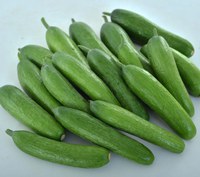Dakota Gardener: Great cucumbers for your garden
(Click an image below to view a high-resolution image that can be downloaded)
By Tom Kalb, Horticulturist
NDSU Extension
Cucumbers are one of the most popular vegetables grown in the Dakotas. The fruits are wonderful in salads, sandwiches and snacks.
I work with hundreds of gardeners in North Dakota every summer in the testing of promising vegetable varieties. When we started this project 15 years ago, the most popular cucumber variety was Straight Eight.
Straight Eight is a good cucumber. This old variety from 1935 produces straight, 8-inch fruits with good flavor.
Over the years, we have learned there are many varieties that are much better.
There are varieties today that ripen earlier and taste less bitter. There are varieties today with fruits that have darker green skin, crisper flesh, smoother skin and smaller seeds. There are varieties today that have healthier and more productive vines.
The most remarkable variety we have tested in recent years is Green Light. This snacking cucumber is harvested when only three inches long. The slender, smooth fruits of Green Light are sweet, crisp and flavorful. Gardeners are amazed at the earliness and productivity of the variety. The vines resist diseases and keep producing until frost.
We all need to eat more vegetables, and this is a delicious snack to grow and enjoy.
If you are looking for a standard slicing cucumber, there are several outstanding varieties. Raider, General Lee and Bristol are especially noteworthy for their earliness, productivity and reliability in the north.
We encourage our team of gardeners to try new vegetables and new varieties. We offer burpless varieties and many of our gardeners have fallen in love with them. After growing a burpless cucumber, many gardeners never go back to growing a standard slicer.
Burpless types are available today that are extremely early and productive. They have the highest fruit quality with slender shapes, thin skins and tiny seeds. Their taste is flavorful and free of any bitterness. They resist many diseases so you keep picking and picking until frost. Some gardeners have confessed they get so exhausted of harvesting that they pull out their plants to stop production.
The best burpless types come from Asia. These include Summer Dance, Tasty Green, Orient Express II and Nokya. Our gardeners in 2023 were very impressed with Sashimi and Unagi, two new varieties that did not require bees for pollination. That’s impressive!
These burpless varieties are truly amazing and I strongly encourage you to try them. Growing a modern burpless variety instead of growing Straight Eight is like driving a new car instead of a Model T Ford. There is no comparison. You will be amazed at the yields and qualities of these varieties.
The only shortcoming of burpless varieties is they are not good for pickling. The best variety for pickling in our trials has consistently been Homemade Pickles (a suitable name). It produces a tremendous amount of fruits that are solid and perfect for making crisp, delicious pickles. Other good picklers include Calypso, Max Pack and H-19 Little Leaf.
Over 400 families tested promising vegetable varieties in their gardens for North Dakota State University last summer. All gardeners in our region are welcome to join our team. For more information, go to ag.ndsu.edu/homegardenvarietytrials/. There you can download our complete listing of recommended vegetable varieties as well as a listing of companies that offer these seeds.
Spring is coming. Sow great varieties this year and get ready for your greatest garden ever!
For more information about gardening, contact your local NDSU Extension agent. Find the Extension office for your county at ndsu.ag/countyoffice.
NDSU Agriculture Communication – Jan. 16, 2024
Source: Tom Kalb, 701-877-2585, tom.kalb@ndsu.edu
Editor: Kelli Anderson, 701-231-7006, kelli.c.anderson@ndsu.edu




